


AH-1W Super Cobra
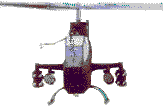
In 1966, the DOD
contracted with Bell Helicopter, Inc. (BHI) for 1,100
AH-1G aircraft, which logged more than 1 million flight
hours in Vietnam. Subsequently, the USMC
desired a twin engine AH-1G; thus, the SEA COBRA (AH-1J)
was developed. The United States Marine
Corps (USMC) then identified a
need for more armaments; thus, the AH-1T upgrade was
initiated. This aircraft had an extended tailboom and
fuselage and an upgraded transmission and engines.
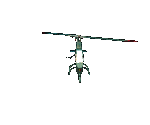 The AH-1 is fully capable of performing its
attack mission in all weather conditions. Additional missions include direct air support, antitank, armed escort, and air to air combat. The TOW missile targeting system uses a telescopic sight unit (traverse 110º, elevation 60º/+30º), a laser augmented tracking capability, thermal sights and a FLIR to allow for acquisition, launch, and tracking of all types of TOW missiles in all weather conditions. The Cobra also uses a digital ballistic computer, a HUD, Doppler nav, and a low speed air data sensor on the starboard side for firing, and has in-flight boresighting. External stores are mounted on underwing external stores points. Each wing has two hardpoints for a total of four stations. A representative mix when targeting armor formations would be eight TOW missiles, two 2.75-in rocket pods, and 750x 20-mm rounds. The gun must be centered before firing underwing stores. Armored cockpit can withstand small arms fire, and composite blades and tailboom are able withstand damage from 23-mm cannon hits.small arms fire, and composite blades and tailboom able to withstand damage from 23-mm cannon hits.
The AH-1 is fully capable of performing its
attack mission in all weather conditions. Additional missions include direct air support, antitank, armed escort, and air to air combat. The TOW missile targeting system uses a telescopic sight unit (traverse 110º, elevation 60º/+30º), a laser augmented tracking capability, thermal sights and a FLIR to allow for acquisition, launch, and tracking of all types of TOW missiles in all weather conditions. The Cobra also uses a digital ballistic computer, a HUD, Doppler nav, and a low speed air data sensor on the starboard side for firing, and has in-flight boresighting. External stores are mounted on underwing external stores points. Each wing has two hardpoints for a total of four stations. A representative mix when targeting armor formations would be eight TOW missiles, two 2.75-in rocket pods, and 750x 20-mm rounds. The gun must be centered before firing underwing stores. Armored cockpit can withstand small arms fire, and composite blades and tailboom are able withstand damage from 23-mm cannon hits.small arms fire, and composite blades and tailboom able to withstand damage from 23-mm cannon hits.
The Marines depend on attack helicopters to provide
close-in fire support coordination in serial and ground
escort operations. Such support is required
during amphibious ship-to-shore movements and subsequent
shore operations within the objective area.
AH-1 is designed for
the following tasks:
- Armed escort for
helicopters carrying personnel and cargo
- Landing zone fire
suppression support
- Visual armed
reconnaissance
- Target marking and
direction for high-performance attack aircraft
- Convoy escort and fire
suppression for ground units
- Operations from air
capable ships
- Point target attack of
threatening armor
- Self-defense and
protection of helicopters carrying personnel and cargo
from threatening air-to-air weapon-equipped helicopters
By the early 1980s, USMC
aircraft inventory was declining due to attrition; a
fully navalized helicopter was sought. In 1983, the USMC
contracted with BHI for 44 AH-1Ws.
The AH-1W Super Cobra is a day/night marginal weather Marine Corps attack helicopter that provides enroute escort for our assault helicopters and their embarked forces. The AH-1W is a two-place, tandem-seat, twin-engine helicopter capable of land- or sea-based operations. The AH-1W provides fire support and fire support coordination to the landing force during amphibious assaults and subsequent operations ashore. The AH-1W distinguished
itself with its more powerful T700-GE-401 fully marinized
engines and advanced electronic weapons capability.
The AH-1W can fire TOW,
Hellfire, and Sidewinder missiles and can be outfitted
with Zuni rocket launchers.
The AH-1W is operated in eight composite HMLA squadrons composed of 18 AH-1 and 9 UH-1 aircraft. The AH-1W is curretnly being outfitted with a Night Targeting System/Forward Looking Infrared Radar that provides laser rangefinding/designating and camera capabilities.
The AH-1W is operated in eight composite HMLA squadrons composed of 18 AH-1 and 9 UH-1 aircraft. The Marine Corps deployed 4 of 6 active force squadrons (48 AH-1Ws) to Southwest Asia during Operation Desert Shield/Desert Storm. These helicopters destroyed 97 tanks, 104 armored personnel carriers and vehicles, 16 bunkers and 2 antiaircraft artillery sites without the loss of any aircraft. The deployment required no additional augmentation to squadron support personnel and only one Bell Helicopter technical representative.
AH-1Z
A four bladed version of the AH-1W, designated the AH-1Z, is also under development; the addition of the extra blades dramatically improves the performance envelope of the AH-1W. Currently, the AH-1W is being retrofitted with a Kollsman-manufactured Night Targeting System (NTS). The aircraft is also undergoing a cockpit reconfiguration to allow for easier copilot/gunner access to the NTS. The upgrade of the AH-1W, including the new cockpit, is referred to as the Four Bladed AH-1W (4BW) and the upgrade of the UH-1N drive train is referred to as the Four Bladed UH-1N (4BN). Collectively, the 4BN/4BW effort constitutes the USMC H-1 Upgrades Program.
The Marine Corps plans to upgrade 180 of the AH-1W gunships to the new AH-1Z standard. The first flight is expected in October 2000, to be followed by low-rate initial production beginning in February 2002, with deliveries running from 2004 through 2013.
This program combines upgrades of two USMC H-1 aircraft: the AH-1W Cobra attack helicopter and the UH-1N light utility helicopter. The common element of the two will be identical twin engines and drive trains, including a new four-bladed rotor previously developed but not fielded. In addition, the AH-1 attack helicopter will gain a new integrated cockpit and night targeting system. The upgrade will extend the life of the H-1 two models well into the 21st century. The AH-1 will contribute to precision engagement and full-dimensional protection; the UH-1 will provide support to focused logistics.
Under the 4BW/4BN fully integrated cockpits will be
phased into the development after initial work on the drive system is underway. Initial work will consist of simultaneous design
efforts for the 4BW and 4BN. Major modifications include: a new rotor system with semi-automatic bladefold of the new
composite rotor system, a new performance matched transmission, a new 4-bladed tail rotor and drive system, a more effective
stabilizer, upgraded landing gear, tail pylon structural modifications and common cockpits. This remanufacture will add 10,000
flight hours to 4BW/4BN airframes. The 4BW will increase aircraft maneuverability, speed, and payload (ordnance) capability.
The fully integrated cockpits will reduce operator workload and improve situational awareness, thus increasing safety. It will
provide growth potential for future weapon systems and avionics, which would increase mission effectiveness and survivability.
As discrete systems have previously been added to both aircraft, pilot workload has progressively worsened. The cockpits will
include integration of on-board mission planning, communications, digital fire control, self navigation, night targeting, and
weapons systems in nearly identical crew stations reducing training requirements. The 4BN effort will incorporate the 4BW
rotor system into the UH-1N aircraft, as well as a fully integrated cockpit common with the 4BW, maximizing commonality
between the two aircraft and providing needed improvements in crew and passenger survivability, payload, power available,
endurance, range, airspeed, maneuverability and supportability.
The 4BN/4BW program was instituted in the summer of 1996 by combining several lesser upgrades
planned but not executed by the Marine Corps. Prior to entry into EMD in September, 1996, DOT&E
approved the program's alternative LFT&E plan and USD(A&T) approved a waiver from full-up,
system-level LFT&E. The AH-1W will be tested full-up, system-level; the UH-1N received a waiver
from full-up, system-level testing. The H-1 Upgrade ORDs require that both helicopters be tolerant to
impacts by 12.7mm rounds and have crashworthy enhancements. Additionally, the drive components of
the AH-1W should be tolerant to 23mm rounds.
The H-1 Upgrade has the most comprehensive and realistic aircraft LFT&E program approved to date.
The program will include full-up, system-level testing of an AH-1W and testing of all but the tail (which is
common to both aircraft) of the UH-1N. It will explore in detail various potential kill mechanisms related
to the expected threat. The LFT&E program is integrated fully into the systems engineering effort and
should yield a reasonable opportunity to incorporate improvements if deficiencies are found.
VARIANTS
Most older Cobra variants still in operation
have been upgraded to the AH-1F standard.
Also produced in Romania and Japan under
license from Bell Textron in the U.S.
- AH-1G: Initial production model in 1966
- AH-1S: Upgraded 1960s produced aircraft
in late 1980s to the standard TOW carry-ing
version.
- AH-1P: A set of AH-1S aircraft fitted with
composite rotors, flat plate glass cockpits,
and NVG capabilities.
- AH-1E: A set of AH-1S aircraft upgraded
with the Enhanced Cobra Armament System
incorporating the universal turret, 20-mm
gun, automatic compensation for off-axis
gun firing, and weapon management system.
- AH-1F: Current standard Cobra. Also
referred to as the “Modernized Cobra”.
Incorporated all past upgrades.
Specifications
|
|
Contractor: |
Bell Helicopter TEXTRON,
Inc. (Prime), General Electric, Kollsman Inc.
|
| Power Plant: |
Two General Electric
T700-GE-401 Turboshaft engines
Each engine delivers
1,690 horsepower.
|
| Accommodations: |
Two seats, in tandem
(pilot in rear, copilot/gunner in front)
|
| Performance: |
Climb rate: 1,925
feet per minute
Maximum altitude:
14,750 feet
Maximum attainable
speed: 170 knots (195 mph)
Maximum cruising
speed: 152 knots (173 mph)
|
| Countermeasures: |
AN/ALE-39 Chaff
system and SUU-4/1 Flare dispensers
|
| Armament: |
One M197 three barrel
20 mm gun (mounted under the nose with 750 round
ammo container)
Underwing attachments
for four TOW missiles, eight Hellfire missiles,
or one AIM-9L Sidewinder missile
Can also be equipped
with Zuni rocket launchers
|
External
Dimensions
| Main rotor
diameter |
14.63 m |
| Main rotor blade
chord |
00.84 m |
| Tail rotor
diameter |
02.97 m |
| Tail rotor blade
chord |
00.305 m |
| Distance between
rotor centers |
08.89 m |
| Wing span |
03.28 m |
| Wing aspect ratio |
03.74 |
| Length: overall,
rotors turning |
17.68 m |
| Length: fuselage |
13.87 m |
| Width overall |
03.28 m |
| Height (to top of
rotor head) |
04.11 m |
| Overall height |
04.44 m |
| Ground clearance,
main rotor, turning |
02.74 m |
| Elevator span |
02.11 m |
| Width over skids |
02.24 m |
|
Areas
| Main rotor blades
(each) |
006.13 m2 |
| Tail rotor blades
(each) |
000.45 m2 |
| Main rotor disc |
168.11 m2 |
| Tail rotor disc |
006.94 m2 |
| Vertical fin |
002.01 m2 |
| Horizontal tail
surfaces |
001.41 m2 |
|
Weights and Loadings
| Weight empty |
004.634 kg |
| Mission fuel load
(usable) |
946 kg |
| Maximum useful
load (fuel and disposable ordinance) |
002.065 kg |
| Maximum Takeoff
and landing weight |
006.690 kg |
| Maximum disc
loading |
039.80 kg/m2 |
| Maximum power
loading |
004.42 kg/kW |
|
Performance (At Maximum T-O weight, ISA)
| Never exceed
speed (Vne) |
190
knots |
| Maximum level
speed at S/L |
152
knots |
| Rate of climb at
S/L, OEI |
244
m/minute |
| Service ceiling |
More
than 4,720 m |
| Service ceiling,
OEI |
More
than 3,660 m |
| Hovering ceiling |
- IGE
|
4,
495 m |
- OGE
|
915
m |
| Range at S/L with
standard fuel, no reserves |
317
nm |
|
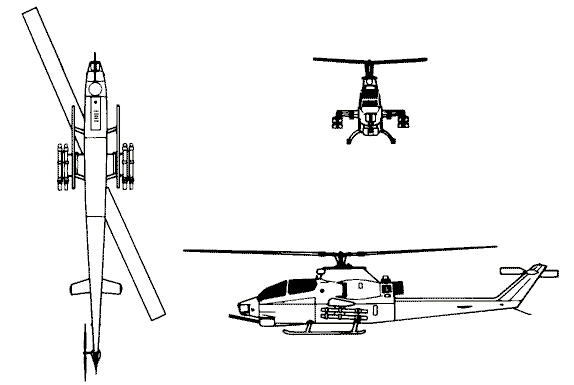
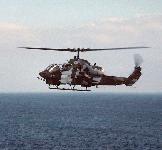
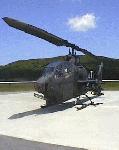
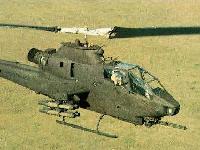
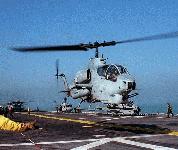
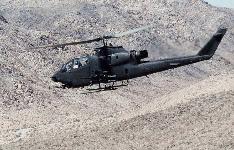
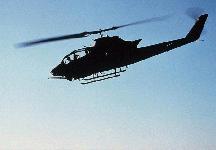
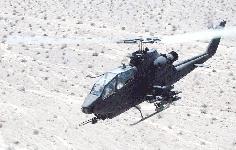
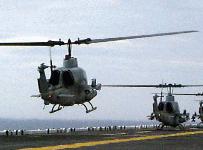
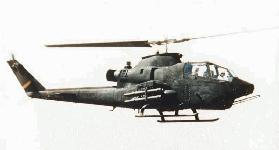
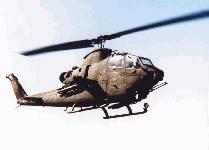
Sources and Resources
http://www.fas.org/man/dod-101/sys/ac/.htm
Maintained by Robert Sherman
Originally created by John Pike
Updated Monday, December 27, 1999 5:25:18 PM
 The AH-1 is fully capable of performing its
attack mission in all weather conditions. Additional missions include direct air support, antitank, armed escort, and air to air combat. The TOW missile targeting system uses a telescopic sight unit (traverse 110º, elevation 60º/+30º), a laser augmented tracking capability, thermal sights and a FLIR to allow for acquisition, launch, and tracking of all types of TOW missiles in all weather conditions. The Cobra also uses a digital ballistic computer, a HUD, Doppler nav, and a low speed air data sensor on the starboard side for firing, and has in-flight boresighting. External stores are mounted on underwing external stores points. Each wing has two hardpoints for a total of four stations. A representative mix when targeting armor formations would be eight TOW missiles, two 2.75-in rocket pods, and 750x 20-mm rounds. The gun must be centered before firing underwing stores. Armored cockpit can withstand small arms fire, and composite blades and tailboom are able withstand damage from 23-mm cannon hits.small arms fire, and composite blades and tailboom able to withstand damage from 23-mm cannon hits.
The AH-1 is fully capable of performing its
attack mission in all weather conditions. Additional missions include direct air support, antitank, armed escort, and air to air combat. The TOW missile targeting system uses a telescopic sight unit (traverse 110º, elevation 60º/+30º), a laser augmented tracking capability, thermal sights and a FLIR to allow for acquisition, launch, and tracking of all types of TOW missiles in all weather conditions. The Cobra also uses a digital ballistic computer, a HUD, Doppler nav, and a low speed air data sensor on the starboard side for firing, and has in-flight boresighting. External stores are mounted on underwing external stores points. Each wing has two hardpoints for a total of four stations. A representative mix when targeting armor formations would be eight TOW missiles, two 2.75-in rocket pods, and 750x 20-mm rounds. The gun must be centered before firing underwing stores. Armored cockpit can withstand small arms fire, and composite blades and tailboom are able withstand damage from 23-mm cannon hits.small arms fire, and composite blades and tailboom able to withstand damage from 23-mm cannon hits.














